Prelude to Glory: “Chief” Anderson’s Momentous Flight – 11 April 1941
“If I see a Black pilot, I’m going to be like, ‘Boy, I hope he’s qualified.’”—Charlie Kirk
The comment above by a prominent white, right-wing activist in January 2024, well deserving of the blistering criticism it attracted, would not have raised an eyebrow even as late as the year the United States entered the Second World War. Like so many other pivotal moments in American history since Emancipation, Black people have been required to prove their abilities and worthiness to the satisfaction of the white population in authority and to countless ordinary citizens.
The Stubborn Presumption Of Inferiority
Take the case of the military. Well into the Civil War (1861-1865), there was urgency to find men to replenish troop losses and bolster forces. However, there was also irrational opposition to the most obvious of solutions: enlist former slaves to fight for the liberation of their brethren in the Confederate States. President Abraham Lincoln’s 1863 Emancipation Proclamation not only freed slaves, it permitted them to serve in the Union Army, something Frederick Douglass, the foremost Black leader of his era, had enthusiastically promoted. It had been generally assumed then that Blacks were too lacking in courage and fighting spirit to be good soldiers. By war’s end, nearly 200,000 had fought —16 having earned the coveted Medal of Honour— and their role in defeating the Confederacy was decisive.
Entering the First World War, African Americans soldiers in Europe performed in racially segregated units. Supervised by white officers, they were mainly assigned to work in support services. They were never allowed to become officers in charge of white soldiers, who bristled at the very idea of having to salute them or address them as ‘Sir’. Ironically, it was when some were posted to fight with French forces that they were treated with far more respect and won 171 Légion d’Honneur medals for their valour. The French even allowed Eugene Bullard, a runaway from oppressive Georgia, to join the Foreign Legion and become the first Black American military pilot. Though Black officers had performed admirably in the nation’s wars and skirmishes, very little had changed in terms of their acceptance and respect shown to them as men in uniform. In 1925, the War Department commissioned a study titled Use of Negro Manpower in War, that shaped the basis of policy until the eve of the next world war. The document thoroughly maligned Black men, employing every racist trope its authors could dredge up, asserting in part:
‘. . . the Negro is profoundly superstitious. He is by nature subservient and naturally believes himself inferior to the white. He is jolly, trustable, lively and docile by nature . . . It would be impossible to place (officers) of his race over whites. He has not the physical courage of the white. He cannot control himself in fear of danger to the degree that whites can.’
When closely read it was also apparent that there was fear that Black soldiers, given the opportunity, would rise through the ranks and become insolent and unruly. Thus, as the theory went, they would challenge the white-dominated military chain of command and, more broadly, the social structure of American society. This fear is revealed in sentences like: ‘The Negro’s growing sense of importance will make more and more of a problem and racial troubles can be expected to increase.’
Fast forward to Autumn 1940. Essentially, it was a repeat of what had happened in the early stages of the Civil War with Frederick Douglass and in the First World War with W. E. B. Du Bois. A new generation of notables again lobbied for the large–scale enlistment of Black soldiers, believing another demonstration of patriotism and bravery would likely result in progress towards racial equality. Black leaders still clung to the overly optimistic dream of earning social and political rewards for their people via military service. Thus, as the nation saw World War II approaching, the NAACP’s Walter F. White, the Urban League’s T. Arnold Hill and others in the civil rights community, pressured federal officials to open or expand opportunities for Blacks in the military. They also demanded jobs for Black workers in the defence industry, which promised collateral economic benefits. Moreover, they were excited by the prospect of one day seeing Black airmen soaring aloft, their aeroplane engines droning loudly high above them. Historian, Gene Smith, characterised airmen in the first half of the 20th century as vaunted ‘knights of modern warfare, daring goggled-and-white-scarved duelists of the sky.’ Historian J. Todd Moye added this:
‘. . . (pilots were) considered the cream of the crop, the most technologically advanced. If you think about what pilots look like in the 1940s with their leather jackets and stars and bars, these were the masculine ideal of the day. Every boy wanted to grow up to be a military pilot.’
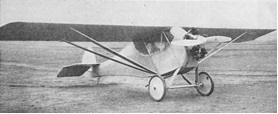
The persistent efforts of Black leaders on behalf of Black airmen, culminated in the formation of an aviation programme in rural Alabama that produced heroes. In 1940 there could not have been a better prepared and accomplished person picked to direct Tuskegee Institute’s Civilian Pilot Training Programme (CPTP), than pioneering 33-year-old, Charles Alfred Anderson. As a boy Anderson was so mesmerised by the rare aeroplane that flew over Bridgeport, Pennsylvania, that he would chase after it for miles until it faded from sight. When a flight school rejected his application on account of his race, he managed to scrape together sufficient money to buy a plane (a Velie Monocoupe), and taught himself how to fly by reading books, observing activities in and around hangars, and listening to and learning from the few broad-minded white pilots kind enough to answer his questions. Still, it took a forceful mentor— a former German First World War aviator—delivering a face-to-face threat to a bigoted flight inspector, for Anderson to be permitted to take a flight test for his pilot’s licence.
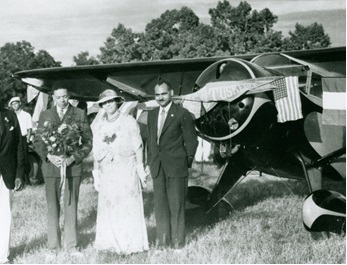
In 1932, Anderson became the first African-American to acquire an air transport pilot’s licence from the Civil Aeronautics Administration. A year later he and Black physician, Albert E. Forsythe made a transcontinental roundtrip flight from Los Angeles to Atlantic City; and in 1934 they completed a ‘goodwill flight’ to the Caribbean and South America in a plane christened The Booker T. Washington. Arriving in 1940 as the Army’s CPTP primary instructor, hard-driving ‘Chief’ Anderson demanded discipline and precision from his cadets. He understood the challenges they would face from an overwhelmingly disapproving military establishment and white civilians writ large. They presumed themselves naturally superior; who feared and/or distrusted African-Americans and felt justified in maintaining the racial caste system, commonly referred to as Jim Crow.
But as the dark clouds of war gathered on the horizon, some prescient souls in the halls of power were increasingly willing to consider expanding the labour force to allow for more women and racially-minoritised workers on the home front when soldiers were shipped off to battle. They might even experiment with training Black cadets to join that esteemed fraternity of fighters: Air Corps pilots. It wasn’t an easy proposition to sell. Few in the upper echelons of the military apparatus or in Congress felt the black population possessed sufficient intelligence and dexterity to master flight in general, or aerial combat in particular. President Franklin D. Roosevelt was deeply sceptical about so risky an undertaking with low expectations. Fortunately, his wife was not.
Throwing Caution To The Wind
One of the most beloved of American First Ladies, Anna Eleanor Roosevelt, unlike her husband, held socially and politically progressive views. She counted among her Black friends educator Mary McLeod Bethune, activist-author Pauli Murray, and the inimitable contralto Marian Anderson. Over several decades, mythology has developed concerning why Roosevelt was in Tuskegee, Alabama, on 11 April 1941, and how she was introduced to Chief Anderson, but these are the basic facts. As a board member of the Rosenwald Fund, she had trekked to the historic Black school to attend its annual meeting. A day of touring the airfield and cadet training facilities had been arranged for visiting board members. These also included demonstrations of formation flights, acrobatic flying, and a parachute jump.
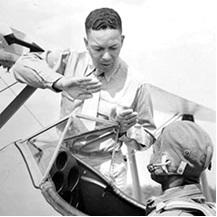
Slightly different versions of what occurred next—the first verbal exchange between Roosevelt and Anderson – were told by newspaper reporters at the scene and confirmed by other sources:
Roosevelt (facetiously): ‘I always heard that coloured people couldn’t fly airplanes but I see you’re flying all around here.’
Anderson: ‘Certainly we can (fly)! We fly everyday down here.’
Roosevelt: ‘Everybody that’s here is flying. You must be able to fly. As a matter of fact, I’m going to find out for sure. I’m going up with you. I wondered if you’d mind taking me up.’
Her unanticipated request greatly alarmed her security team (Secret Service agents), who tried to convince her to reconsider. ‘No, Mrs. Roosevelt! You can’t do that!’, was their refrain. But the First Lady was a strong-willed woman and could not be dissuaded. Anderson, who was delighted to grant her wish, remembered: ‘Well, she just made up her mind she was going to do it and got in the airplane. You don’t argue with the First Lady, so we took off . . .’
For his part, Anderson fully realised the fallout of a problematic flight and the rewards of smooth, trouble-free flight, and was as confident and unflappable as ever. So, after 40 minutes in a trainer plane (JP-3 Piper Cub), circling the Institute’s properties, surveying Macon County and monotonously flat terrain dotted with cotton fields, the plane landed safely without incident, much to the relief of everyone waiting on the runway. ‘Well, I see you can fly all right‘, she complimented Anderson. Upon landing, a photo was snapped of a seemingly buoyant and carefree pilot and his distinguished rear seat passenger. The significance of the flight was not missed by the public. The photo, which Roosevelt insisted be taken, appeared on the front pages of newspapers from coast to coast.
Roosevelt’s security team had ample reason to freak out about the President’s wife and the nation’s beloved 56-year-old First Lady, taking an unscheduled flight with an unvetted Black pilot. Had Roosevelt broken a fingernail while in Anderson’s trainer plane or had he done anything technically inept, the press was there to magnify it. White supremacists and naysayers, who never wanted Blacks to succeed as aviators, would have had a field day—gloating over their dire predictions made real. Had there been a crash that injured or killed Roosevelt, it is easy to imagine the immediate closure of the flight school and a total, long-term prohibition against African-Americans entering the Army Air Corps. Such a scenario, as we shall see, would have had significant military ramifications.
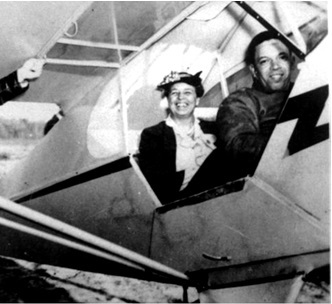
Upon Mrs. Roosevelt’s return to the White House, it is said she brandished the iconic photo, whilst recapping the details of her Tuskegee trip to the President. She duly gave him another earful about the fitness of Black officers to defend America as airmen. Shortly thereafter the War Department gave the green light to a plan it had been sitting on since late 1940, the so-called Tuskegee Experiment. Black cadets taught by white officers would train at Tuskegee to qualify for a racially segregated unit of the United States Army Air Force. Within three months, Anderson transitioned from Tuskegee Institute’s CPTP director to ground commander and chief flight instructor for the Air Force’s new programme. It would produce fighter pilots and supporting ground crew that became the Fighting 99th squadron of the 332nd Fighter Group.
Once Doubted, Now Immortalised
In his new position Anderson supervised the training of 996 Black pilots, 450 of whom flew roughly 1,400 combat missions over parts of North Africa and Europe during the Second World War. They were famously known as Red Tails because of the deep red tail markings on the vertical
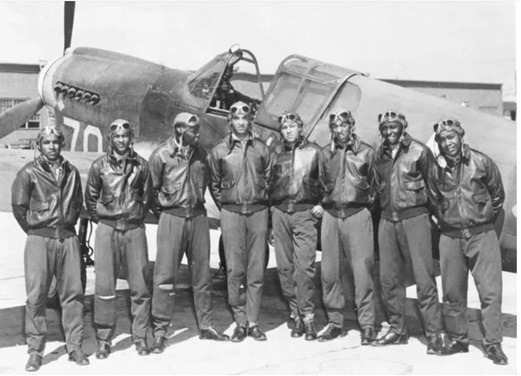
stabilisers of their P-40 Warhawks, P-47 Thunderbolts, and their P-51 Mustangs; rated the best fighter plane of the war. Their superb training prepared them for the struggle ahead, and what was ahead was a list of impressive feats that made them legend, to wit: approximately 1,500 missions flown that occasioned 15,000 sorties; the destruction or disabling of 400 enemy aircraft, including blasting three German fighter jets out of the sky late in the war, and the sinking of a German navy destroyer in the harbour of Trieste, Italy, firing only their machine guns. Furthermore, they earned an unsurpassed reputation for protecting bombers they escorted over enemy territory. Among their awards and recognitions were eight Purple Hearts, 14 Bronze Stars, multiple Silver Stars, 744 Air Medals, 96 Distinguished Flying Crosses, a Presidential Citation, and France’s Croix de Guerre.
The valued contributions of an assortment of Black ground troops’ war effort, combined with the smashing success of the Tuskegee Airmen, hastened the racial integration of all branches of the American armed forces which occurred in late 1940s. Anderson’s effective instruction and management supplied hundreds of first-rate fighter pilots that contributed to Allied victory in Europe. The first black men to become Air Force generals—Benjamin O. Davis Jr. in 1954 and Chappie James in 1970—both trained at Tuskegee under Anderson. After many more years of flight instruction and mentoring young airmen, Anderson died in Tuskegee in 1996. In 2013 he was enshrined in the National Aviation Hall of Fame, joining the likes of Amelia Earhart, Chuck Yeager, and Charles Lindbergh. Finally, in 2014 his portrait was put on a postage stamp honouring his illustrious career (below, left).
Eleanor Roosevelt’s fly-along with Anderson has been characterised by some writers as ‘The Flight That Changed History’ and, more often, Anderson himself has been lionised as ‘The Father of Black Aviation.’ The extraordinary record of the Tuskegee Airmen in the Second World War became the most widely publicised achievement of a group of African Americans in a military campaign. Their accomplishments, which Anderson was in large part responsible for, evokes amazement, remaining to this day a source of tremendous pride for many of those who know their story.



